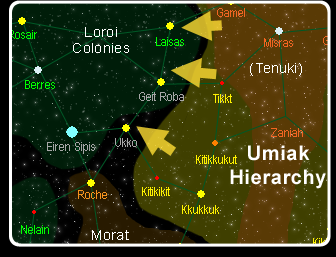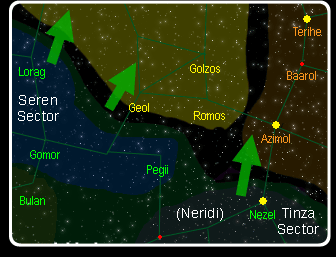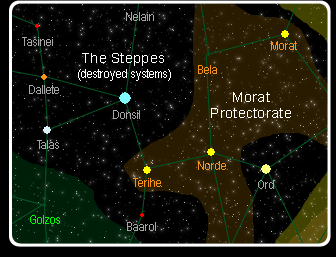|
Data File Updated: Wednesday, July 14, 2021 Outbreak of War: 2135In 2110 CE, the Loroi and Umiak established contact for the first time in the Steppes region of what is now known as the Seren sector. The Loroi Empire, expanding under the unprecedented peace and prosperity of Third Emperor Eighth Dawn's rule, had established new colonies in the region, encroaching on the remote edge of the Umiak sphere of influence. Early relations seemed civil, though traders from both sides were restricted to frontier ports. Both empires had roughly similar levels of technology, much of it collected from their respective stables of client states. The Loroi naturally regarded the Umiak as a potential threat (as they did all alien races), but by this point in their history, the Loroi had become deeply convinced of their own natural superiority, and had grown accustomed to peaceful domination of their neighbors through the Loroi Union. The Umiak did not share this complacent view, as would soon become evident.
The first year of the war was an unmitigated disaster for the Loroi. Though the substantial Loroi forces in the region were highly professional and well-equipped, they had not seen actual combat for centuries, and were badly outnumbered by an unfamiliar enemy. Umiak vessels were tough and numerous, and the Umiak showed no reluctance to brave Loroi fire and absorb the losses required to get their forces into close-range combat with the Loroi, where Umiak plasma weaponry gave them a distinct advantage. The Umiak advanced so rapidly that it was all Loroi defenders could do to retreat ahead of them and keep from being completely overrun. In December of 2135, when Loroi reinforcements arrived in numbers, the Umiak had already captured most of the Loroi colonies in the Steppes region. The Loroi launched a counter-offensive through then-neutral Morat territory in an attempt to cut off the Umiak forces bearing down on Seren, but this operation failed when the Morat abruptly sided with the Umiak and, with Umiak support, expelled the invasion. Loroi forces fell back to the Seren capital and formed a defensive perimeter along the frontier of the Seren and Tinza sectors. For the next two and a half years, in what would be called the First Siege of Seren, the Umiak would learn how tenacious the Loroi could be in strategic defense. A series of massive Umiak assaults down the Seren Corridor were repulsed with heavy losses and without significant Umiak gains. Unable to penetrate the defenses of Seren, the Umiak launched attacks all along the Seren-Tinza perimeter, but the ability of Loroi Farseers to predict enemy attacks allowed the Loroi to concentrate their limited forces only where they were most needed. Loroi defenses bent but refused to break. Given the horrendous casualties that the Loroi were inflicting upon the Umiak at this point, the Loroi felt confident that they could bleed the Umiak dry in a war of attrition if they maintained a successful defense. Fall of Seren and Historian Alliance: 2139-2140Confounding Loroi expectations, the Umiak showed no sign of weakening, despite the losses they were taking. On the contrary, in early 2139, the Umiak expanded the scale of operations by opening up attacks on three new fronts. One new avenue of attack came through the Loroi Maiad sector, which previously had no contact with the Umiak, but which the Umiak through expansion were now able to reach. Second, Umiak forces began making raids on the Laget and Nelomani systems through supposedly-neutral Tithric space. Third, and most surprisingly, the Umiak conducted a full-scale invasion of Historian-controlled space near to Seren, seeking a route around the stronghold. The Historians hastily concluded a defense treaty with the Loroi, but Loroi forces sent to aid the Historians could do little to prevent Umiak advances, as the Historian defenders offered only minimal resistance to the Umiak invaders and withdrew to the interior of their territory, abandoning systems to the Umiak. With the backdoor to Seren now open, and with increasing pressure on two other fronts, the defense of the sector capital became untenable, and it had to be abandoned in June of 2139. Evacuation plans had been incomplete, and millions of Loroi civilians on Seren fell into Umiak hands. By mid-2140, the Loroi were very near to complete collapse. Steadily losing ground in the Maiad sector, the Loroi managed to cling to the Golim territory that was the last remnant of the Seren sector, but the raids from Tithric space threatened to fatally weaken the Golim-Tinza perimeter and possibly even break through into the Loroi and Neridi heartlands. In the one bright spot for the Loroi in 2140, the Historians finally launched a counterattack on Umiak positions in their former territory -- too late to prevent the loss of Seren -- but in recompense agreed to some limited sharing of the formidable Historian technology with the Loroi. The Fourth Loroi EmperorIn the darkest hour of the war for the Loroi, 16 August 2140, the Third Emperor Eighth Dawn herself was killed when her Imperial squadron, acting as a last reserve, was forced into action to fill a breach in the Tinza perimeter. The Torrai Diadem council chose an unconventional successor: Admiral Greywind, an outspoken political opponent of the late Emperor and a former Mizol with ties to the intelligence community. The selection outraged loyalists and prompted accusations of treachery in the circumstances of the former Emperor's death. After a brief internal struggle, Greywind crushed her opposition, instituted martial law in Union territory, and aggressively implemented the reforms that she had criticized the former Emperor for being slow to act on. Industrial infrastructure was nationalized, and private assets of some wealthy civilians and aliens accused of war profiteering were seized. The worlds of the Union would become an engine of total war. Fourth Emperor Greywind also announced a new anti-neutrality doctrine, aimed directly at the neighboring Tithric, who at best were unable to prevent Umiak sorties through their neutral territory, and at worst may have been actively assisting them. Greywind sent Admiral Sunfall, hero of the Golim-Tinza battles, to force the Tithric to choose sides. While the Tithric government delayed, Sunfall began conducting strikes into Tithric territory to interdict Umiak forces, but also to destroy depots that Sunfall claimed were being used to refuel Umiak raiders. Tithric public outrage over these raids resulted in the rise of a pro-Umiak government to power, and the Tithric formally sided with the Umiak in mid-2141. In a battle that lasted most of that year, Sunfall shattered the combined Umiak and Tithric forces and (with Imperial consent) laid waste to the Tithric planets, rendering them unusable to the Umiak, and annihilating the vast majority of the Tithric population. With the pressure on Laget and Nelomani relieved, the Loroi celebrated this event as a critical victory, but the genocide came as a shock to the other races, including many Loroi allies. The Umiak shortly thereafter declared a similar doctrine refusing to recognize the rights of neutrality, and both sides would use this policy in the coming years as pretext for action against and annexation of the remaining non-aligned nations. By 2142, Umiak forces had reached their deepest penetration yet into Loroi territory, but allied victories in Historian and Tithric territories allowed the Loroi to secure their defensive perimeters, and over the next two years, continuing major Umiak offensives would fail to push the Loroi any further. Semoset Campaign: 2144-2146
The assault seemed to take the Umiak off guard, and the spearheading fleets led by Admiral Sunfall, after heavy fighting through the numerous Umiak bivouac divisions crowded at the front, successfully breached the Umiak lines. Umiak reinforcements streamed toward the front, but their counterattacks were sporadic and disorganized, and some battles saw substantial Umiak fleets retreating from combat, an event unheard of only a few years earlier. The Loroi made steady progress, pushing the Umiak back and retaking lost territory, sensing that they had perhaps finally broken the back of the enemy. As the Loroi recaptured populated systems that had been previously lost to the Umiak, the worst of Loroi fears over the fates of those who had fallen under Umiak occupation were confirmed. For years, fierce and effective Loroi resistance had prevented the Umiak from making much use of the captured worlds; Teidar and Mizol could be devastating guerrilla fighters, and were nearly impossible to identify among the civilian Loroi population. After a few years of unsuccessful occupation, the Umiak concluded that pacification of the Loroi was impossible, and simply began extermination of the captive Loroi populations. Of the estimated 50 million civilian Loroi that had been trapped on Seren when it was lost to the Umiak six years earlier, fewer than 600,000 still remained alive on the planet when it was recaptured in 2145. The story was the same on every recaptured Loroi colony. Following the recapture of Seren, thereafter the Loroi showed no mercy to any Umiak taken prisoner as the offensive pushed forward. By mid-2146, Sunfall's forces had advanced through Seren into the Steppes, and were on the verge of pushing into pre-war Umiak territory. Loroi hopes that the end of the war might be in sight diminished as the Umiak seemed to regain confidence and began to defend and counterattack more effectively, and the Loroi offensive ground to a standstill at Nelain. Now pressed against Umiak-inhabited systems, Loroi Farseers had a more difficult time detecting Umiak fleets moving within their own territory, and their ability to track and predict Umiak fleet movements suffered. After a series of battles at Nelain in which the Loroi held firm against major Umiak counterattacks, the Loroi were shocked to realize that these had only been a diversion to tie up Sunfall's forces while the Umiak launched massive pincer attacks through Donsil and Tedel. The Umiak had been assembling reserves and holding them in Umiak territory near populated planets, where the Loroi Farseers could not easily detect them. While Sunfall's main force was still engaged in heavy fighting at Nelain, Loroi reserve forces had to contend with one of the largest Umiak assaults of the war in a running fight that became known as the Battle of the Tasinei Ways. It is a tribute to the second-tier Loroi fleets thrown into the fighting (including the Emperor's personal squadron) that they were somehow able to prevent the Umiak from breaking out into undefended Loroi territory, but they could not keep the Umiak from completely cutting off Sunfall's forces in the Nelain salient. Isolated and deprived of supply, Sunfall's only option was to attempt to break through the encirclement, but unfortunately this meant attacking directly into the stream of Umiak reinforcements. Sunfall's fleet was overwhelmed and completely annihilated. Dispirited, having lost nearly a third of their active combat vessels and an entire generation of their best commanders along with the now-legendary Admiral Sunfall, the surviving Loroi forces laid waste to the remaining Steppes systems and fell back to the familiar defensive positions around Seren. Maiad Campaign and Stalemate: 2147-2160
The war entered a state of bloody stalemate. The Umiak kept up offensive attacks through the depopulated zones, maintaining pressure on Loroi defenders, with the aim of preventing the Loroi from accumulating reserves that they might use for a decisive offensive. The Loroi relied on their defensive advantages, stretching their fast-interdiction defenses thinly, attempting to build reserves for just such an offensive. Emperor Greywind waited and watched for the moment when such forces could be used to decisive effect. The Umiak also seemed to be holding back the majority of their reserves, similarly waiting for a key moment. In 2160, the opportunity that both sides had been waiting for arrived, but in a most unexpected form. See also: Loroi, Umiak, Loroi Timeline |
![]()
1
2
3
4
5
6
7
8
9
10
11
12
13
14
15
16
17
![]()
18
19
20
21
22
23
24
25
26
27
28
29
30
31
32
33
34
35
36
37
38
39
40
41
42
43
44
45
46
47
48
49
50
51
52
53
54
55
56
57
58
59
60
61
62
63
64
65
66
67
68
69
70
71
72
73
74
75
76
77
78
79-80
81
82
83
84
85
86
87
88
89
90
91
![]()
92
93
94
95
96
97
98
99
100
101
102
103
104
105
106
107
108
109
110
111
112
113
114
115
116
117
118
119
120
121
122
123
124
125
126
127
128
129
130
131
132
133
134
135
136
137
138
139
140
141
142
143
144
145
146
147
148
149
150
151
152
153
154
155
156
157
158
159
160
161
162
163
164
165
166
167
168
169
170
171
172
173
174
175
176
177
178
179
180
181
182
183
184
185
186
187
188
189
190
191
192
193
194
195
196
197
198
199
![]()
200
201
202
203
204
205
206
207
208
209
210
211
212
213
214
215
216
217
218
219
220
221
222
223
224
225
226

 As both empires continued to
expand, the growing friction between them reached a flash point
in the border system of Ukko on 10 August 2135. Loroi and Umiak warships exchanged fire,
though each side tells a version of the incident that differs in
who initiated the combat. What is not in dispute is that the Umiak response was immediate, massive,
and had clearly been prepared in advance. Numerous Umiak fleets
attacked Loroi space from all along the Tenuki border. The scale
of the invasion was unprecedented; it was as if the Umiak had
begun preparing for war at the very moment of first contact with
the Loroi.
As both empires continued to
expand, the growing friction between them reached a flash point
in the border system of Ukko on 10 August 2135. Loroi and Umiak warships exchanged fire,
though each side tells a version of the incident that differs in
who initiated the combat. What is not in dispute is that the Umiak response was immediate, massive,
and had clearly been prepared in advance. Numerous Umiak fleets
attacked Loroi space from all along the Tenuki border. The scale
of the invasion was unprecedented; it was as if the Umiak had
begun preparing for war at the very moment of first contact with
the Loroi. The month-long Loroi celebration
known as Semoset, which is observed every 28 years to coincide
with the regular arrival of a Deinarid comet, approached again
at the beginning of 2144. As the war entered its ninth year, a
new generation of warriors conceived in those early days of the
war (when the peacetime breeding restrictions were first lifted)
had now
completed the rites of passage and were ready for combat in
significant numbers. The
infrastructure reforms instituted by Greywind had revitalized
Loroi war industry, and ships armed with new weaponry derived from the Historian
technology exchange (such as the pulse cannon) were now reaching
the front in quantity. Rather than the traditional feasts and
games held in honor of Semoset, the Loroi observed the holiday
by launching their largest offensive of the war.
The month-long Loroi celebration
known as Semoset, which is observed every 28 years to coincide
with the regular arrival of a Deinarid comet, approached again
at the beginning of 2144. As the war entered its ninth year, a
new generation of warriors conceived in those early days of the
war (when the peacetime breeding restrictions were first lifted)
had now
completed the rites of passage and were ready for combat in
significant numbers. The
infrastructure reforms instituted by Greywind had revitalized
Loroi war industry, and ships armed with new weaponry derived from the Historian
technology exchange (such as the pulse cannon) were now reaching
the front in quantity. Rather than the traditional feasts and
games held in honor of Semoset, the Loroi observed the holiday
by launching their largest offensive of the war. As the fighting in the Seren
sector returned to a static defensive mode, action in the Maiad sector now heated up. Still smarting from the dramatic swings of
fortune brought over the previous eleven years, both sides became
more conservative in both their offensive and defensive moves.
The events of the Semoset collapse had left the Loroi with a
disproportionate number of light raider-type ships, and the
Loroi became forced to rely on these for both interdiction
strikes on attacking Umiak fleets crossing the new wide Steppes
dead zone, and quick hit-and-run raids on Umiak-held systems
across the closer Maiad frontier. Although it did not gain them
any ground, the Loroi were very successful in both of these
modes. After nearly five years of these Loroi raids, this time it was the
Umiak who razed and abandoned systems at the Maiad border to
create a buffer zone similar to that in the newly-renamed
Charred Steppes.
As the fighting in the Seren
sector returned to a static defensive mode, action in the Maiad sector now heated up. Still smarting from the dramatic swings of
fortune brought over the previous eleven years, both sides became
more conservative in both their offensive and defensive moves.
The events of the Semoset collapse had left the Loroi with a
disproportionate number of light raider-type ships, and the
Loroi became forced to rely on these for both interdiction
strikes on attacking Umiak fleets crossing the new wide Steppes
dead zone, and quick hit-and-run raids on Umiak-held systems
across the closer Maiad frontier. Although it did not gain them
any ground, the Loroi were very successful in both of these
modes. After nearly five years of these Loroi raids, this time it was the
Umiak who razed and abandoned systems at the Maiad border to
create a buffer zone similar to that in the newly-renamed
Charred Steppes.